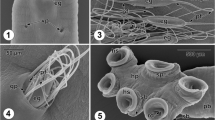Abstract
Electron microscopy has revealed the presence of specialised basal cells at the base of the periostracal groove in the bivalves Mytilus edulis (L), Nucula sulcata Bronn., Cardium edule (L) and Macoma balthica (L). A common basal cell type is observed which gives rise to a pellicle in all cases except N. sulcata. The pellicle is the first part of the periostracum to be elaborated, and it is suggestd that it may be an indication of specialisation in bivalves. In N. sulcata and C. edule, an additional cell type is present. In N. sulcata, this second basal cell type appears to be directly involved in periostracum formation, whereas in C. edule an indirect role is proposed.
Similar content being viewed by others
Literature cited
Baudhuin, P., H. Beaufay and C. de Duve: Combined biochemical and morphological study of particulate fractions from rat liver. Analysis of fractions rich in lysosomes or in particles containing urate oxidase, D-amino acid oxidase and catalase. J. Cell Biol. 26, 219–243 (1965a).
—, M. Muller, B. Poole and C. de Duve: Non mitochondrial oxidising particles (microbodies) in rat liver and kidney and in Tetrahymena pyriformis. Biochem. biophys. Res. Commun. 20, 53–59 (1965b).
Beedham, G. E.: Observations on the mantle of the Lamellibranchia. Q. Jl microsc. Sci. 99, 181–197 (1958).
—: Repair of the shell in species of Anodonta. Proc. Zool. Soc. 145, 107–124 (1965).
Bergenhayn, von, J. R. M.: Kurze Bemerkungen zur Kenntnis der Schalenstruktur und Systematik der Loricaten. K. svenska Vetensk-Akad. Handl. 9, 1–6 (1930).
Bevelander, G. and H. Nakahara: An electron microscope study of the formation of the periostracum of Macrocallista maculata. Calc. Tissue Res. 1, 55–67 (1967).
Dunachie, J. F.: The periostracum of Mytilus edulis. Trans. R. Soc. Edinb. 65, 383–411 (1963).
Hopkins, C. R. and B. I. Baker: The fine structural localisation of acid phosphatase in the prolactin cell of the eel pituitary. J. Cell Sci. 3, 357–364 (1968).
Jamieson, J. D. and G. Palade: Intracellular transport of secretory proteins in the pancreatic exocrine cell. I. Role of the peripheral elements of the Golgi complex. J. Cell Biol. 34, 577–645 (1967).
Kado, Y.: Studies on shell formation in molluscs. J. Sci. Hiroshima Univ. 19, 163–210 (1960).
Kawaguti, S. and N. Ikemoto: Electron microscopy on the mantle of a bivalved gastropod. Biol. J. Okayama Univ. 8, 1–20 (1962a).
—: Electron microscopy on the mantle of a bivalve, Fabulina nitidula. Biol. J. Okayama Univ. 8, 21–42 (1962b).
— and G. Yasuzumi: Electron microscope studies on the mantle of the pearl oyster Pinctada martensi Dunker. Preliminary report. The fine structure of the periostracum fixed with permanganate. J. Electron Microse., Tokyo 13, 119–123 (1964).
Kniprath, E.: Die Feinstruktur der Periostrakungrube von Lynnaea stagnalis. Biomineralisation 2, 23–37 (1970).
—: Formation and structure of the periostracum in Lymnaea stagnalis. Cale. Tissue Res. 9, 260–271 (1972).
Knorre von, H.: Die Schale und die Rückensinnesorgane von Trachydermon (chiton) cinereus L. Jena. Z. Naturw. 61, 469–632 (1925).
Levetzow, von, K. G.: Die Struktur einiger Schneckenschalen und ihre Entstehung durch typisches und atypisches Wachstum. Jena. Z. Naturw. 66, 41–108 (1932).
Manigault, P.: Coquille des mollusques: structure et formation. Traite Zool. 5, 1823–1844 (1960).
Morton, J. E. and C. M. Yonge: Classification and structure of the Mollusea. In: Physiology of the Mollusca, Vol. I. pp 1–57. Ed. by K. M. Wilbur and C. M. Yonge. New York and London: Academic Press 1964.
Mutvei, H.: On the shells of Nautilus and Spirula with notes on shell secretion in non-cephalopod molluscs. Ark. Zool. 16, 221–278 (1964).
Novikoff, A. B. and W. Shin: The endoplasmic reticulum in the Golgi zone and its relation to microbodies, Golgi apparatus and autophagic vacuoles in rat liver cells. J. Microsc. 3, 187–206 (1964).
Smith, R. E. and G. M. Farquhar: Lysosome function in the regulation of the secretory process in cells of the anterior pituitary gland. J. Cell Biol. 31, 319–347 (1966).
Timmermans, L. P. M.: Studies in shell formation in molluscs. Neth. J. Zool. 19, 417–523 (1969).
Tsujii, T.: Studies on the mechanisms of shell and pearl formation in Mollusca. J. Fac. Fish. pref. Univ. Mie-Tsu 5, 1–70 (1960).
Wattiaux-de Coninck, S., M. J. Rutgeerts and R. Wattiaux: Lysosomes in rat-kidney tissue. Biochim. biophys. Acta 105, 446–459 (1965).
Author information
Authors and Affiliations
Additional information
Communicated by J. H. S. Blaxter, Oban
Rights and permissions
About this article
Cite this article
Bubel, A. An electron-microscope study of periostracum formation in some marine bivalves. I. The origin of the periostracum. Marine Biology 20, 213–221 (1973). https://doi.org/10.1007/BF00348987
Accepted:
Issue Date:
DOI: https://doi.org/10.1007/BF00348987




